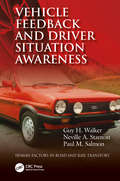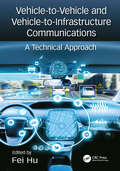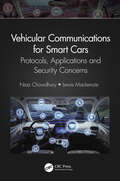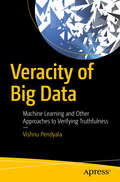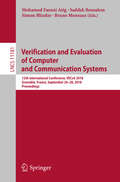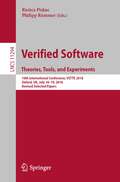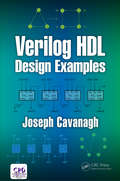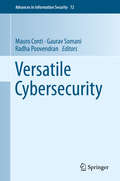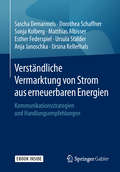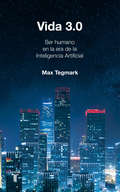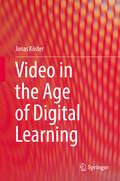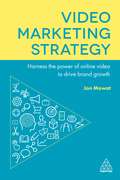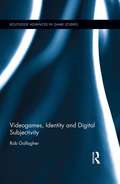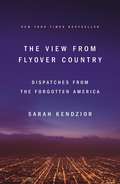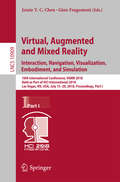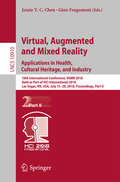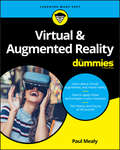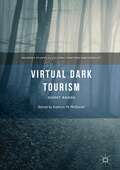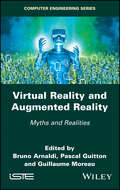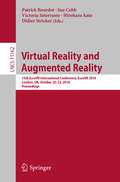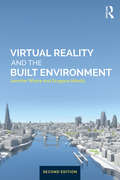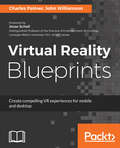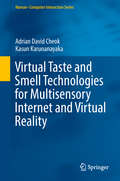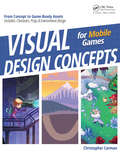- Table View
- List View
Vehicle Feedback and Driver Situation Awareness (Human Factors in Road and Rail Transport)
by Neville A. Stanton Guy H. Walker Paul M. SalmonA potentially troubling aspect of modern vehicle design – some would argue - is a trend for isolating the driver and reducing vehicle feedback, usually in the name of comfort and refinement but increasingly because of automation. There is little doubt cars have become more civilised over the years, yet despite this, the consequences of driver behaviour remain to a large extent anecdotal. Readers will have heard such anecdotes for themselves. They usually take the form of drivers of a certain age recalling their first cars from the 1970s or 80s, in which "doing 70 mph really felt like it". The question is whether such anecdotes actually reflect a bigger, more significant issue that could be better understood. Related questions have been explored in other domains such as aviation, where the change to ‘fly-by-wire’ did indeed bring about some occasionally serious performance issues that were not anticipated. Despite some clear parallels, automotive systems have been left relatively unstudied. The research described in this book aims to explore precisely these issues from a Human Factors perspective. This means connecting the topics of vehicle feel, vehicle dynamics, and automotive engineering with the latest research on driver situation awareness. The problem is explored experimentally from a variety of theoretical viewpoints but the outcomes are consistently practical. Here we have a promising new avenue along which the driver experience can be enhanced in novel and insightful ways. Tools and templates are provided so that engineers and designers can try different ways to boost vehicle safety, efficiency and enjoyment from a human-centered perspective. Association of American Publishers (AAP) Finalist for the 2019 PROSE Award Features Diagnosis of how vehicle feel impacts driver situation awareness, and how this could aid future vehicle designs Multi-theory approach to driver situation awareness, and how different views of this important concept give rise to different insights Comprehensive analysis of situation awareness in driving, the information requirements of drivers, and how these needs can be supported Practical descriptions of how state-of-science Human Factors methods have been applied in practice
Vehicle-to-Vehicle and Vehicle-to-Infrastructure Communications: A Technical Approach
by Fei HuThis book focuses on the most critical technical aspects of vehicle-to-vehicle (V2V) and vehicle-to-infrastructure (V2I) communications. It covers the smart city concept and architecture and explains how V2V and V2I fit into it. It describes the wireless communication protocols for V2V and V2I. It then explains the hardware design process for vehicle communication transceiver and antenna systems. It explains next-generation wireless technologies and their requirements for vehicle communication protocols. Case studies provide the latest V2V and V2I commercial design details. Finally, it describes how to implement vehicle communication protocol from practical hardware design angle.
Vehicular Communications for Smart Cars: Protocols, Applications and Security Concerns
by Niaz Chowdhury Lewis MackenzieThis book covers a wide range of topics from the smart transportation domain. It discusses protocols, applications and security concerns in various vehicular networks using examples and easy-to-understand figures. The first four chapters focus on vehicular network protocols and applications, while the remaining four chapters incorporate security, trust and privacy issues with examples from real-life cases. The book concludes with a vision of what to expect in the near future and will be an invaluable resource for anybody interested in this nascent technology and its variegated applications. Dr. Niaz Chowdhury is a postdoctoral research associate at the Knowledge Media Institute, the Open University in England. Dr. Lewis M. Mackenzie is a senior lecturer in computing science at the University of Glasgow.
Veracity of Big Data: Machine Learning and Other Approaches to Verifying Truthfulness
by Vishnu PendyalaExamine the problem of maintaining the quality of big data and discover novel solutions. You will learn the four V’s of big data, including veracity, and study the problem from various angles. The solutions discussed are drawn from diverse areas of engineering and math, including machine learning, statistics, formal methods, and the Blockchain technology. Veracity of Big Data serves as an introduction to machine learning algorithms and diverse techniques such as the Kalman filter, SPRT, CUSUM, fuzzy logic, and Blockchain, showing how they can be used to solve problems in the veracity domain. Using examples, the math behind the techniques is explained in easy-to-understand language.Determining the truth of big data in real-world applications involves using various tools to analyze the available information. This book delves into some of the techniques that can be used. Microblogging websites such as Twitter have played a major role in public life, including during presidential elections. The book uses examples of microblogs posted on a particular topic to demonstrate how veracity can be examined and established. Some of the techniques are described in the context of detecting veiled attacks on microblogging websites to influence public opinion.What You'll LearnUnderstand the problem concerning data veracity and its ramificationsDevelop the mathematical foundation needed to help minimize the impact of the problem using easy-to-understand language and examplesUse diverse tools and techniques such as machine learning algorithms, Blockchain, and the Kalman filter to address veracity issuesWho This Book Is ForSoftware developers and practitioners, practicing engineers, curious managers, graduate students, and research scholars
Verification and Evaluation of Computer and Communication Systems: 12th International Conference, VECoS 2018, Grenoble, France, September 26–28, 2018, Proceedings (Lecture Notes in Computer Science #11181)
by Mohamed Faouzi Atig Saddek Bensalem Simon Bliudze Bruno MonsuezThis book constitutes the proceedings of the 12th International Conference on Verification and Evaluation of Computer and Communication Systems ( VECoS 2018) held at Grenoble, France, in September 2018. The 11 full papers in this volume, presented together with one abstract and two invited papers, were carefully reviewed and selected from 23 submissions. The aim of the VECoS conference is to bring together researchers and practitioners in the areas of verification, control, performance, and dependability evaluation in order to discuss state of the art and challenges in modern computer and communication systems in which functional and extra-functional properties are strongly interrelated. Thus, the main motivation for VECoS is to encourage the cross-fertilization between various formal verification and evaluation approaches, methods and techniques, and especially those developed for concurrent and distributed hardware/software systems.
Verified Software. Theories, Tools, and Experiments: 10th International Conference, VSTTE 2018, Oxford, UK, July 18–19, 2018, Revised Selected Papers (Lecture Notes in Computer Science #11294)
by Ruzica Piskac Philipp RümmerThis volume constitutes the thoroughly refereed post-conference proceedings of the 10th International Conference on Verified Software: Theories, Tools, and Experiments, VSTTE 2018, held in Oxford, UK, in July 2018.The 19 full papers presented were carefully revised and selected from 24 submissions. The papers describe large-scale verification efforts that involve collaboration, theory unification, tool integration, and formalized domain knowledge as well as novel experiments and case studies evaluating verification techniques and technologies.
Verilog HDL Design Examples
by Joseph Cavanagh<p>The Verilog language provides a means to model a digital system at many levels of abstraction from a logic gate to a complex digital system to a mainframe computer. The purpose of this book is to present the Verilog language together with a wide variety of examples, so that the reader can gain a firm foundation in the design of the digital system using Verilog HDL. <p>The Verilog projects include the design module, the test bench module, and the outputs obtained from the simulator that illustrate the complete functional operation of the design. Where applicable, a detailed review of the theory of the topic is presented together with the logic design principles—including: state diagrams, Karnaugh maps, equations, and the logic diagram. Numerous examples and homework problems are included throughout. The examples include logical operations, counters of different moduli, half adders, full adders, a carry lookahead adder, array multipliers, different types of Moore and Mealy machines, and arithmetic logic units (ALUs).</p>
Versatile Cybersecurity (Advances in Information Security #72)
by Radha Poovendran Gaurav Somani Mauro ContiCyber security research is one of the important areas in the computer science domain which also plays a major role in the life of almost every individual, enterprise, society and country, which this book illustrates. A large number of advanced security books focus on either cryptography or system security which covers both information and network security. However, there is hardly any books available for advanced-level students and research scholars in security research to systematically study how the major attacks are studied, modeled, planned and combated by the community. This book aims to fill this gap. This book provides focused content related to specific attacks or attack families. These dedicated discussions in the form of individual chapters covers the application or area specific aspects, while discussing the placement of defense solutions to combat the attacks. It includes eight high quality chapters from established security research groups worldwide, which address important attacks from theoretical (modeling) as well as practical aspects. Each chapter brings together comprehensive and structured information on an attack or an attack family. The authors present crisp detailing on the state of the art with quality illustration of defense mechanisms and open research problems. This book also covers various important attacks families such as insider threats, semantics social engineering attacks, distributed denial of service attacks, botnet based attacks, cyber physical malware based attacks, cross-vm attacks, and IoT covert channel attacks. This book will serve the interests of cyber security enthusiasts, undergraduates, post-graduates, researchers and professionals working in this field.
Verständliche Vermarktung von Strom aus erneuerbaren Energien
by Sascha Demarmels Dorothea Schaffner Sonja Kolberg Matthias Albisser Esther Federspiel Ursula Stalder Anja Janoschka Ursina KellerhalsDieses Buch untersucht, wie sich Stromprodukte aus erneuerbaren Energien verständlich vermarkten lassen, sodass die Konsumentinnen und Konsumenten den Mehrwert dieser Produkte verstehen und eine informierte Kaufentscheidung treffen. Eine Toolbox liefert Handlungsempfehlungen und erläutert Kommunikationsstrategien wie Gamification, Storytelling, Vereinfachung und Visualisierung. Basis der Handlungsempfehlungen sind Experteninterviews, in Experimenten getestete Pilotbeispiele sowie von Partnerunternehmen entwickelte Kommunikationsbeispiele, die in der Praxis umgesetzt und als Feldexperiment geprüft wurden.Der InhaltStrommarkt und -marketing in den DACH LändernForschungsstand "Angewandte Verständlichkeit"Kommunikationsstrategien zur Steigerung der Verarbeitungsmotivation und deren ValidierungBest-Practice-Beispiele aus verschiedenen Ländern Toolbox.
Vida 3.0
by Max Tegmark¿Cómo afectará la inteligencia artificial al crimen, a la guerra, a la justicia, al trabajo, a la sociedad y al sentido de nuestras vidas? Bienvenidos a la conversación más importante de nuestro tiempo. ¿Cómo afectará la inteligencia artificial al crimen, a la guerra, a la justicia, al trabajo, a la sociedad y al sentido de nuestras vidas? ¿Es posible que las máquinas nos dejen fuera de juego, remplazando a los humanos en el mercado laboral e incluso en otros ámbitos? ¿La inteligencia artificial proveerá mejoras sin precedente a nuestras vidas o nos dará más poder del que podemos manejar? Muchas de las cuestiones más fundamentales de la actualidad están íntimamente relacionadas con el aumento de la inteligencia artificial. Max Tegmark no se asusta ante la gama completa de puntos de vista o ante los temas más controvertidos, desde la superinteligencia hasta el significado, la conciencia y los límites físicos últimos de la vida en el cosmos. En Vida 3.0, clarifica los conceptos clave necesarios para hablar de inteligencia artificial al tiempo que ayuda a entender la importancia de las cuestiones clave, aquellas que la humanidad tendrá que abordar en las próximas décadas. Reseñas:«Todos nosotros, no solo científicos, industriales y generales, deberíamos preguntarnos qué puede hacerse ahora para aumentar las posibilidades de cosechar los beneficios de la IA futura y evitar sus riesgos. Esta es la conversación más importante de nuestro tiempo, y con este estimulante libro Tegmark te ayudará a participar en ella.»Stephen Hawking «Enriquecedor y visionario. Todo el mundo debería leerlo.»The Times «Tegmark explica con brillantez numerosos conceptos del terreno de la informática al de la cosmología, escribe con modestia y sutileza intelectual, le ofrece al lector el importante servicio de definir sus términos con claridad, y con razón rinde homenaje a las mentes creativas de los escritores de ciencia ficción que, por supuesto, abordaron este tipo de preguntas hace más de medio siglo.»Steven Poole, The Telegraph «Original, accesible y provocador. Tegmark ilumina las numerosas facetas de la inteligencia artificial. Disfruten del viaje y saldrán del otro extremo con una mejor apreciación de adónde podría llevarnos la tecnología en los próximos años.»Science «Una guía convincente por los retos y dilemas en nuestra búsqueda de un gran futuro de la vida, la inteligencia y la consciencia, en la Tierra y más allá de esta.»Elon Musk Estimulante. La discusión inteligente y desenfrenada de Tegmark conduce a fascinantes especulaciones sobre civilizaciones basadas en la inteligencia artificial que abarcan galaxias y eones. Absorbente.»Publishers Weekly
Vida 3.0
by Max Tegmark¿Cómo afectará la inteligencia artificial al crimen, a la guerra, a la justicia, al trabajo, a la sociedad y al sentido de nuestras vidas? Bienvenidos a la conversación más importante de nuestro tiempo. ¿Cómo afectará la inteligencia artificial al crimen, a la guerra, a la justicia, al trabajo, a la sociedad y al sentido de nuestras vidas? ¿Es posible que las máquinas nos dejen fuera de juego, remplazando a los humanos en el mercado laboral e incluso en otros ámbitos? ¿La inteligencia artificial proveerá mejoras sin precedente a nuestras vidas o nos dará más poder del que podemos manejar? Muchas de las cuestiones más fundamentales de la actualidad están íntimamente relacionadas con el aumento de la inteligencia artificial. Max Tegmark no se asusta ante la gama completa de puntos de vista o ante los temas más controvertidos, desde la superinteligencia hasta el significado, la conciencia y los límites físicos últimos de la vida en el cosmos. En Vida 3.0, clarifica los conceptos clave necesarios para hablar de inteligencia artificial al tiempo que ayuda a entender la importancia de las cuestiones clave, aquellas que la humanidad tendrá que abordar en las próximas décadas. Reseñas:«Todos nosotros, no solo científicos, industriales y generales, deberíamos preguntarnos qué puede hacerse ahora para aumentar las posibilidades de cosechar los beneficios de la IA futura y evitar sus riesgos. Esta es la conversación más importante de nuestro tiempo, y con este estimulante libro Tegmark te ayudará a participar en ella.»Stephen Hawking «Enriquecedor y visionario. Todo el mundo debería leerlo.»The Times «Tegmark explica con brillantez numerosos conceptos del terreno de la informática al de la cosmología, escribe con modestia y sutileza intelectual, le ofrece al lector el importante servicio de definir sus términos con claridad, y con razón rinde homenaje a las mentes creativas de los escritores de ciencia ficción que, por supuesto, abordaron este tipo de preguntas hace más de medio siglo.»Steven Poole, The Telegraph «Original, accesible y provocador. Tegmark ilumina las numerosas facetas de la inteligencia artificial. Disfruten del viaje y saldrán del otro extremo con una mejor apreciación de adónde podría llevarnos la tecnología en los próximos años.»Science «Una guía convincente por los retos y dilemas en nuestra búsqueda de un gran futuro de la vida, la inteligencia y la consciencia, en la Tierra y más allá de esta.»Elon Musk Estimulante. La discusión inteligente y desenfrenada de Tegmark conduce a fascinantes especulaciones sobre civilizaciones basadas en la inteligencia artificial que abarcan galaxias y eones. Absorbente.»Publishers Weekly
Video in the Age of Digital Learning
by Jonas KösterAlthough video is now ubiquitous in education, its full potential is oftentimes not fully understood, nor is it used to utmost potential. This timely volume seeks to address this gap by providing educators and instructional designers with a comprehensive and in-depth understanding of video production processes and methods for designing effective instructional videos. From its discussion of the significance of digital learning and impact of instructional video to its unique focus on the best design and production techniques that make video an effective teaching tool, this book offers applicable and tested strategies for creating quality instructional video. The accompanying website, which allows readers to see sample videos and access additional online resources, underscores the book’s practitioner focus. Among the topics covered: · Instructional videos for teaching and learning · Design and interactivity of instructional videos · Production, distribution, and integration of instructional videos · The future of instructional video Video in the Age of Digital Learning is an important, practical contribution to the scholarship exploring methods for sharing and acquiring knowledge in the digital age. It promises to be a valuable resource for educators, instructional designers, instructional media producers, and educational technology professionals.
Video Marketing Strategy: Harness the Power of Online Video to Drive Brand Growth
by Jon MowatVideo is the single most effective tool that marketers have to raise brand awareness, increase sales, drive website traffic and deliver ROI on marketing budgets. Driven by consumer demand and with the backing of the largest social media platforms, our world is becoming 'video first'. Video Marketing Strategy allows marketers to harness the power of video and create effective video campaigns. This in-depth look at the world's most powerful medium helps brands to radically magnify their voice by tapping into a level of emotional engagement that can't be achieved any other way. The book explores both theory (why are humans so affected by video on mobile devices?) and practice (what's the key to making videos that deliver results?). It looks at how multiple videos form wider campaigns and covers content hubs, activation strategies and testing. It is filled with invaluable advice, tips and strategies for incorporating video into a wider content marketing plan. Written by an award-winning video marketer with decades of experience, Video Marketing Strategy gives readers the magic formula to create engaging, effective content. Truly global in scope, it features case studies from around the world, and shows how marketers from all sectors and industries have used video campaigns successfully. Featuring insights from prominent industry practitioners Video Marketing Strategy is jam-packed with guidance on how to make videos that cut through the market place and deliver measurable results.
Videogames, Identity and Digital Subjectivity (Routledge Advances in Game Studies)
by Rob GallagherThis book argues that games offer a means of coming to terms with a world that is being transformed by digital technologies. As blends of software and fiction, videogames are uniquely capable of representing and exploring the effects of digitization on day-to-day life. By modeling and incorporating new technologies (from artificial intelligence routines and data mining techniques to augmented reality interfaces), and by dramatizing the implications of these technologies for understandings of identity, nationality, sexuality, health and work, games encourage us to playfully engage with these issues in ways that traditional media cannot.
The View from Flyover Country: Dispatches from the Forgotten America
by Sarah KendziorFrom the St. Louis–based journalist often credited with first predicting Donald Trump’s presidential victory."A collection of sharp-edged, humanistic pieces about the American heartland...Passionate pieces that repeatedly assail the inability of many to empathize and to humanize." — KirkusIn 2015, Sarah Kendzior collected the essays she reported for Al Jazeera and published them as The View from Flyover Country, which became an ebook bestseller and garnered praise from readers around the world. Now, The View from Flyover Country is being released in print with an updated introduction and epilogue that reflect on the ways that the Trump presidency was the certain result of the realities first captured in Kendzior’s essays.A clear-eyed account of the realities of life in America’s overlooked heartland, The View from Flyover Country is a piercing critique of the labor exploitation, race relations, gentrification, media bias, and other aspects of the post-employment economy that gave rise to a president who rules like an autocrat. The View from Flyover Country is necessary reading for anyone who believes that the only way for America to fix its problems is to first discuss them with honesty and compassion.“Please put everything aside and try to get ahold of Sarah Kendzior’s collected essays, The View from Flyover Country. I have rarely come across writing that is as urgent and beautifully expressed. What makes Kendzior’s writing so truly important is [that] it . . . documents where the problem lies, by somebody who lives there.”—The Wire“Sarah Kendzior is as harsh and tenacious a critic of the Trump administration as you’ll find. She isn’t some new kid on the political block or a controversy machine. . . .Rather she is a widely published journalist and anthropologist who has spent much of her life studying authoritarianism.” —Columbia Tribune
Virtual, Augmented and Mixed Reality: 10th International Conference, VAMR 2018, Held as Part of HCI International 2018, Las Vegas, NV, USA, July 15-20, 2018, Proceedings, Part I (Lecture Notes in Computer Science #10909)
by Jessie Y.C. Chen Gino FragomeniThis two-volume set LNCS 10909 and 10910 constitutes the refereed proceedings of the 10th International Conference on Virtual, Augmented and Mixed Reality, VAMR 2018, held as part of HCI International 2018 in Las Vegas, NV, USA. HCII 2018 received a total of 4346 submissions, of which 1171 papers and 160 posters were accepted for publication after a careful reviewing process. The 65 papers presented in this volume were organized in topical sections named: interaction, navigation, and visualization in VAMR; embodiment, communication, and collaboration in VAMR; education, training, and simulation; VAMR in psychotherapy, exercising, and health; virtual reality for cultural heritage, entertainment, and games; industrial and military applications.
Virtual, Augmented and Mixed Reality: 10th International Conference, VAMR 2018, Held as Part of HCI International 2018, Las Vegas, NV, USA, July 15-20, 2018, Proceedings, Part II (Lecture Notes in Computer Science #10910)
by Jessie Y.C. Chen Gino FragomeniThis two-volume set LNCS 10909 and 10910 constitutes the refereed proceedings of the 10th International Conference on Virtual, Augmented and Mixed Reality, VAMR 2018, held as part of HCI International 2018 in Las Vegas, NV, USA. HCII 2018 received a total of 4346 submissions, of which 1171 papers and 160 posters were accepted for publication after a careful reviewing process. The 65 papers presented in this volume were organized in topical sections named: interaction, navigation, and visualization in VAMR; embodiment, communication, and collaboration in VAMR; education, training, and simulation; VAMR in psychotherapy, exercising, and health; virtual reality for cultural heritage, entertainment, and games; industrial and military applications.
Virtual & Augmented Reality For Dummies
by Paul MealyAn easy-to-understand primer on Virtual Reality and Augmented Reality Virtual Reality (VR) and Augmented Reality (AR) are driving the next technological revolution. If you want to get in on the action, this book helps you understand what these technologies are, their history, how they’re being used, and how they’ll affect consumers both personally and professionally in the very near future. With VR and AR poised to become mainstream within the next few years, an accessible book to bring users up to speed on the subject is sorely needed—and that’s where this handy reference comes in! Rather than focusing on a specific piece of hardware (HTC Vive, Oculus Rift, iOS ARKit) or software (Unity, Unreal Engine), Virtual & Augmented Reality For Dummies offers a broad look at both VR and AR, giving you a bird’s eye view of what you can expect as they continue to take the world by storm. * Keeps you up-to-date on the pulse of this fast-changing technology * Explores the many ways AR/VR are being used in fields such as healthcare, education, and entertainment * Includes interviews with designers, developers, and technologists currently working in the fields of VR and AR Perfect for both potential content creators and content consumers, this book will change the way you approach and contribute to these emerging technologies.
Virtual Dark Tourism: Ghost Roads (Palgrave Studies In Cultural Heritage And Conflict )
by Kathryn N. McDanielThis book takes the concept of “dark tourism”—journeys to sites of death, suffering, and calamity—in an innovative yet essential direction by applying it to the virtual realms of literature, film and television, the Internet, and gaming. Essays focus both on the creative construction of imaginary journeys and the historiographic and civic consequences of such memorializations. From World War II time-travel novels to Game of Thrones, and from Internet reproductions of Rwandan genocide locations to invented tragedies in futuristic domains, authors from various fields examine the purpose and influence of simulated travels to morbid sites. Designed for a wide audience of scholars and travelers virtual and real, this volume raises awareness about the many pathways through which we encounter death experiences in contemporary society. What we know about the past—or, what we think we know about it—is shaped daily by such imagined journeys as these.
Virtual Reality and Augmented Reality: Myths and Realities
by Bruno Arnaldi Pascal Guitton Guillaume MoreauVirtual and Augmented Reality have existed for a long time but were stuck to the research world or to some large manufacturing companies. With the appearance of low-cost devices, it is expected a number of new applications, including for the general audience. This book aims at making a statement about those novelties as well as distinguishing them from the complexes challenges they raise by proposing real use cases, replacing those recent evolutions through the VR/AR dynamic and by providing some perspective for the years to come.
Virtual Reality and Augmented Reality: 15th EuroVR International Conference, EuroVR 2018, London, UK, October 22–23, 2018, Proceedings (Lecture Notes in Computer Science #11162)
by Patrick Bourdot Sue Cobb Victoria Interrante Hirokazu Kato Didier StrickerThis book constitutes the refereed proceedings of the 15th International Conference on Virtual Reality and Augmented Reality, EuroVR 2018, held in London, UK, in October 2018. The 9 full papers and 6 short papers presented were carefully reviewed and selected from 39 submissions. The papers are organized in 5topical sections: vision-based motion tracking; 3D acquisition and 3D reconstruction; haptics and 3D audio; perception and cognition; interactive techniques and use-case studies.
Virtual Reality and the Built Environment
by Jennifer Whyte Dragana NikolićLike the first edition, the central question this book addresses is how virtual reality can be used in the design, production and management of the built environment. The book aims to consider three key questions. What are the business drivers for the use of virtual reality? What are its limitations? How can virtual reality be implemented within organizations? Using international case studies it answers these questions whilst addressing the growth in the recent use of building information modelling (BIM) and the renewed interest in virtual reality to visualize and understand data to make decisions. With the aim of inspiring and informing future use, the authors take a fresh look at current applications in the construction sector, situating them within a broader trajectory of innovation. The new edition expands the scope to consider both immersive virtual reality as a way of bringing professionals inside a building information model, and augmented reality as a way of taking this model and related asset information out to the job-site. The updated edition also considers these technologies in the context of other developments that were in their infancy when the first edition was written – such as laser scanning, mobile technologies and big data. Virtual Reality in the Built Environment is essential reading for professionals in architecture, construction, design, surveying and engineering and students on related courses who need an understanding of BIM, CAD and virtual reality in the sector. Please follow the book's Twitter account: @vrandbe http://buildingvr.blogspot.co.uk/
Virtual Reality Blueprints: Create compelling VR experiences for mobile and desktop
by John Williamson Charles PalmerJoin the virtual reality revolution by creating immersive 3D games and applications with Cardboard VR, Gear VR, OculusVR, and HTC Vive Key Features Develop robust, immersive VR experiences that are easy on the eye. Code 3D games and applications using Unity 3D game engine. Learn the basic principles of virtual reality applications Book Description Are you new to virtual reality? Do you want to create exciting interactive VR applications? There's no need to be daunted by the thought of creating interactive VR applications, it's much easier than you think with this hands-on, project-based guide that will take you through VR development essentials for desktop and mobile-based games and applications. Explore the three top platforms—Cardboard VR, Gear VR, and OculusVR —to design immersive experiences from scratch. You’ll start by understanding the science-fiction roots of virtual reality and then build your first VR experience using Cardboard VR. You'll then delve into user interactions in virtual space for the Google Cardboard then move on to creating a virtual gallery with Gear VR. Then you will learn all about virtual movements, state machines, and spawning while you shoot zombies in the Oculus Rift headset. Next, you'll construct a Carnival Midway, complete with two common games to entertain players. Along the way, you will explore the best practices for VR development, review game design tips, discuss methods for combating motion sickness and identify alternate uses for VR applications What you will learn Use Unity assets to create object simulation. Implement simple touch controls in your application. Apply artificial intelligence to achieve player and character interaction. Add scripts for movement, tracking, grasping, and spawning. Create animated walkthroughs, use 360-degree media, and build engaging VR experiences. Deploy your games on multiple VR platforms. Who this book is for If you are a game developer and a VR enthusiast now looking to get stuck into the VR app development process by creating VR apps for different platforms, then this is the book for you. Familiarity with the Unity game engine and the C# language is key to getting the most from this book.
Virtual Taste and Smell Technologies for Multisensory Internet and Virtual Reality
by Adrian David Cheok Kasun KarunanayakaCurrently, Internet and virtual reality communication is essentially audio-visual. The next important breakthrough of the Internet will be the communication and sharing of smell and taste experiences digitally. Audio-visual stimuli are frequency based, and they can be easily digitized and actuated. On the other hand, taste and smell stimuli are based on chemical molecules, therefore, they are not easy to digitize or actuate. To solve this problem, we are required to discover new digital actuation technologies for taste and smell. The authors of this book have experimented on developing digital actuation devices for several years. This book will provide a complete overview of the importance of digitizing taste and smell, prior works, proposed technologies by the authors, other state of the art research, advantages and limitations of the proposed methods, and future applications. We expect digital taste and smell technologies will revolutionize the field of multisensory augmented reality and open up new interaction possibilities in different disciplines such as Human Computer Interaction, Communication, and Augmented and Virtual Reality.
Visual Design Concepts For Mobile Games
by Chirstopher P CarmanThis book is geared towards both students as well as professionals who are looking to enter the mobile (tablet/smartphone) and PC (personal computer) industry as concept artists (for both 2D and 3D production pipelines) or 2D production artists (game-ready assets). This book is not specifically focused on game design or game development and is also not a 3D modeling or animation guide. However, certain aspects of game design, game development, and 3D modeling and animation will impact the visual development and art creation process. So, at points throughout we will explore topics such as game engine performance and game mechanics, though at a very high-level, bird's-eye, vantage point and only as they pertain to the visual development of the various assignments throughout this book. Through the completion of the exercises and assignments contained within Visual Development for Web & Mobile Games readers will be guided through the visual development process and execution of a variety of concepts and assets (final game art). This includes categories such as characters, props, and backgrounds, within an isometric design template. The categories themselves will relate more to their function within a very simple game design template than their completed visual representation (e.g., the "big build-able" category could be anything from a town square to a fire breathing dragon as long as it fits within the bare bones parameters of the asset types functionality). The concept, theme, and style of these assets, as well as the world they inhabit, will be completely up to the individual artist. Key Features Weaves knowledge of classic visual development principles and web/mobile game art production practices. Assignments and exercises at the end of every chapter allow the reader to create a game art project from start to finish. Examines both 2D/3D game art pipelines. Includes a companion website with project files, asset downloads & author created video tutorials.
